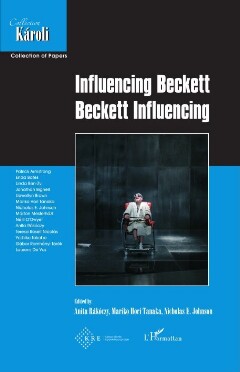Seite 23 [23]
TERESA ROSELL NICOLÁS
THE PROUSTIAN VISION
Beckett’s Proust? (1931) begins with the epigraph “E fango é il mondo” (“And
the world is mud”), taken from Giacomo Leopardi’s poem A se stesso,? which
anticipates both a radical pessimism and a sense of the illusive nature of
existence that are going to be developed in the essay.* “Mud,” the first noun
Beckett wrote on In Search of Lost Time, evokes ubiquity and pervasiveness,
and it is certainly present in Limage (1959) and Comment c'est (1961).5 In these
texts, the use of mud, like sand, clay and dust, already prefigured in Molloy
(1951) “like [in] so many of Beckett’s mud-crawlers,”® can be read literally,
but it could also be translated as the action of flattening or leveling, as the
matter that spreads, covers everything and eliminates any trace of distinctive
identity, thus emphasizing “uniformity” and “the absence of the accidental.”’
It is also inevitable to think of mud as the primeval substance out of which
creation occurs, that is, the potentiality of the particular out of the universal.
According to Lawrence Harvey, “the notion of surface and depth recurs in
Proust.”® The physical being that inhabits the outside world is defined by Beckett
as a “carapace of paste and pewter,”? but “hidden deep within this exterior shell,
in what Proust calls the ‘gouffre interdit à nos sondes’, is the pearl that represents
the essence of our many selves,”!° the multiple identities of the modern subject.
After reading Proust, Beckett understands that the artist does not deal with
the surface and that “art is the apotheosis of solitude.” For him, the only
Proust is widely considered Beckett’s main contribution to literary criticism. In order to
write this essay, he read In Search of Lost Time, Proust’s masterpiece, twice during the
summer of 1930 in the “abominable” edition of the Nouvelle Revue Francaise. The sixteen
volumes that comprise Proust’s completed novel were published from 1913 to 1927, the last
three posthumously. Beckett worked entirely with the original French edition. In the essay
he himself translated into English some citations he used from the French novel without
using the already existing English translation of the first volumes by Scott Moncrieff. Beckett
wrote Proust in the summer of 1930, and it was published in Chatto & Windus, London, in
1931.
Leopardi’s A se stesso is one of the five poems belonging to the Ciclo di Aspasia, included
in I Canti (1835). The volume, edited in 1936 by Ettore Fabietti, Milan, is represented in
Beckett’s library in Paris. (See Dirk Van Hulle - Mark Nixon: Samuel Beckett’s Library, New
York, Cambridge University, 2013, 116 and 276.)
Another, more humorous interpretation could be related to James Joyce, as it seems he
enjoyed the pun “é il mondo” (“the world is”) and “è immondo” (“it is filthy”).
L’Image was first published in French in X: A Quarterly Review, Vol. 1, No. 1 (November
1959), 35-37. It was later developed and included in Comment c'est (1961).
Ulrika Maude: Pavlov’s Dogs and Other Animals in Samuel Beckett, in M. Bryden: Beckett
and Animals, Cambridge, Cambridge University, 2013, 82-93.
Lawrence Harvey: Samuel Beckett: Poet and Critic, Princeton, Princeton University, 1970,
404.
8 Ibid., 404.
° Samuel Beckett: Proust, London, Chatto and Windus, 1931, 19.
10 Harvey: Samuel Beckett, 404.
4 Beckett: Proust, 47.
s 22 e

